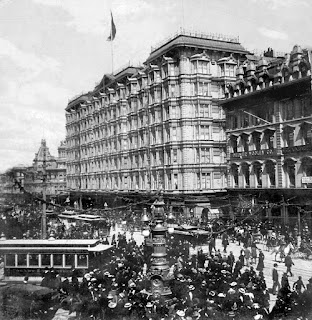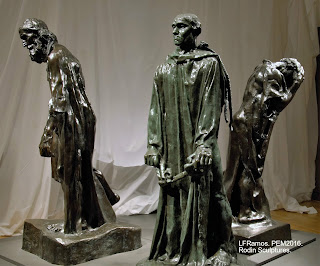Many Filipinos entering the United States for the first time through San Francisco may be surprised to know that national hero Jose Rizal preceded them here more than a century ago.
From Tokyo, he wrote his parents and siblings that "[o]n the 13th of [April 1888] I leave for America on the steamship
Belgic of the Oriental and Occidental Company. I intend to stay in America some weeks and afterward depart for London where I should be toward the end of May."
The steamer sailed from Yokohama, and based on the data from the
'Marine Ships in Port' of 'The Maritime Heritage Project - San Francisco 1846-1899', a voyage of the Belgic in 1890 took 15 days 13 hours and 44 minutes before it dropped anchor at the port in San Francisco.
On Saturday, 28 April, Rizal wrote in his diary: "We arrived in the morning at San Francisco, We docked, They say that we shall be quarantined, The little customs launch came to visit us. They have unloaded the silk cargo: Each bale costs about $700. They are not afraid of the silk and of the lunch."
The next day, Sunday, he noted: "The second day of the quarantine, We are bored. I no longer know how to amuse myself." And he wrote to his parents: "Here we are in sight of America since yesterday without being able to disembark, placed in quarantine on account of the 642 Chinese that we have on board coming from Hong Kong where they say smallpox prevails. But the true reason is that, as America is against Chinese immigration and now they are campaigning for the elections, the government, in order to get the vote of the people, must appear to be strict with the Chinese, and we suffer. On board there is not one sick person."
On the third day: "The quarantine continues. I read in the newspapers a statement of the health inspector against the quarantine." He wrote to his friend Dr. Ferdinand Blumentritt: "We are anchored in this port under quarantine. We don't know how long it will last, although there are no sick passengers aboard and the ship did not come from a filthy port. The reason for this is that we have 643 Chinese passengers and, as elections are approaching, the government wants to be in the good graces of the people. We protest, but it is useless for, as the Spaniards say, it is like exercising the right to kick."
On 01 May, Rizal said they signed a protest against the quarantine and the Englishmen wrote to their consul. After six days of quarantine, in the afternoon of 4 May, they, the first class passengers finally stepped on American soil. The Japanese and Chinese remained on board.
At that time, the disembarkation point was not the postcard Port of San Francisco we see today. So where did the
Belgic docked? Gary Kamiya provided the most probable answer in his book Cool Gray City of Love: "The thousands of Chinese immigrants that poured into the city disembarked at the Pacific Mail Steamship pier, near what is now First and Brannan."
 |
Marker on the wall of the Palace at the Montgomery St-
Market St. corner.
|
From there, Rizal could have taken a coach to the first class Palace Hotel on New Montgomery Street, where he lodged at "$4.00 a day with bath and everything included" Based on the
historical data of 1887, he stayed in a sunny outside room with southern exposure that cost '$4.00 per day and upward.' It was more expensive by a dollar if he stayed in an outside room 'with facing street.' The cheapest were for outside rooms facing open courts: '$2.50, $3.00 and upward.'
There was not much in his diary from which to deduce how Rizal spent his short time in the city,
He simply wrote: "...Stockton St. 312. I saw the Golden Gate ... (one illegible word). The customs-house. A letter of recommendation. On Sunday the stores are closed. The best street in San Francisco is Market Street. Stroll. -- Stanford, the rich man. -- A street near Chinatown."
We must note that Rizal might have been referring to the Golden Gate Strait, the entrance to San Francisco Bay, because the iconic bridge was built in the 1930s. Or, he could have gone to the Golden Gate Park but he could not have walked to this large public park as it was too far from the hotel. He did not mention taking the streetcar that was already running to this place in 1887.
When he stepped out for a walk, the first thing that he could have noticed were the cable cars that had been running along Market Street since 1883. These cars replaced horse-drawn rails. He might have preferred to walk rather than take the cable car; hence, his remark that Market was the best street of the city.
When he strolled on Market, he could have noted at the corner of Geary and Kearny, a short distance from the hotel, Lotta's Fountain: a cast iron sculpture painted in bronze with lion's heads and other ornaments. Historical accounts say that this fountain was presented to the citizens of San Francisco in 1875 by the famous Lotta Crabtree, who started her career as a vaudeville performer in the city during the Gold Rush days.
 |
| The Lotta's Fountain in 1901 when Pres. McKinley visited the Palace Hotel. (Source: Wikipedia) |
 |
| The Lotta's Fountain today near the Palace Hotel. Photo by the author. |
Except for the other buildings and street scenes, the vintage and recent photographs of Palace Hotel with Lotta's Fountain are quite similar except that the original hotel, where Rizal stayed, was gutted by fire in the aftermath of the 1906 earthquake. The reconstructed one was opened in 1909.
'Stanford, the rich man.' Rizal was referring to Leland Stanford, one of the 'Big Four Millionaires' from the Gold Rush and was also dubbed a robber baron. His farm spawned the Stanford University. Did Rizal hear about his anti-Chinese attitude when he was governor of California? He lobbied for the restriction of Chinese immigration during his term.
'A street near China town,' he wrote. Did he go there? The scene could have been similar to Binondo of his student days in Manila.
He was in San Francisco for two days and two nights, and left for Oakland in the late afternoon of 06 May 1888 on a ferry boat. From there, he would board the train that eventually took him on a coast-to-coast journey to New York City.
From London, Rizal would relate his overall impression of America to his friend Mariano Ponce in his letter of 27 July 1888: "I visited the largest cities of America with their big buildings, electric lights, and magnificent conceptions. Undoubtedly America is a great country, but it still has many defects. There is no real civil liberty. In some states the Negro cannot marry a white woman, nor a Negress a white man. Because of the hatred of the Chinese, other Asiatics, like the Japanese, being confused with them, are likewise disliked by the ignorant Americans. The customs is excessively strict. However, as they say rightly, America offers a home to the poor who like to work."
He cited his sad experience in San Francisco: "There was moreover much arbitrariness; for example, when we were in quarantine. They placed us under quarantine, in spite of the clearance given by the American consul, of having been at sea for about one month, of not having a single case of illness aboard, and of the telegram of the governor of Hong Kong declaring that port free from epidemic. We were quarantined because there were on board 800 Chinese and, as elections were being held in San Francisco, the government wanted to boast that is was taking strict measures against the Chinese to win votes and the people's sympathy. We were informed of the quarantine verbally, without specifying its duration. However, on the same day of our arrival, they unloaded 700 bales of silk without fumigating them; the ship's doctor went ashore; many customs employees and an American doctor from the hospital for cholera victims ate on board. Thus we were for about thirteen days. Afterwards only the passengers of the first class were allowed to land, the Japanese and Chinese of the 2nd and 3rd classes remaining in quarantine for an indefinite period. It is said that in that way they got rid of about 300 Chinese, letting them gradually die on board. I don't know if this is true."
In November that year, the Americans were going to elect their president. The incumbent was Grover Cleveland (Democrat). In California, they voted for the Republican challenger Benjamin Harrison.
The Chinese issue of Rizal's time resonates in the present debates on immigration policy between the Republican Donald Trump and the Democrat Hillary Clinton. Trump had swiped at illegal immigrants particularly the Mexicans, but he also clawed at people coming from what he deemed terrorist nations, and tagged the Philippines as one of them. "We're dealing with animals," he trumped.
Note:
Rizal's diary entries and letters were taken from the book Jose Rizal Reminiscences & Travels published by the National Historical Commission of the Philippines in 2011.
Recommended reading on the historical and current views of San Francisco:
Kamiya, Gary. 2013. Cool Gray City of Love: 49 Views of San Francisco. Berryville, VA: Berryville Graphics, Inc,

















